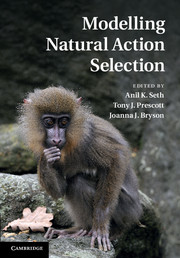1 - General introduction
Published online by Cambridge University Press: 05 November 2011
Summary
Action selection is the task of deciding ‘what to do next’. As a general problem facing all autonomous entities – animals and artificial agents – it has exercised both the sciences concerned with understanding the biological bases of behaviour (e.g., ethology, neurobiology, psychology) and those concerned with building artefacts (e.g., artificial intelligence, artificial life, and robotics). The problem has two parts: what constitutes an action, and how are actions selected?
This volume is dedicated to advancing our understanding of the behavioural patterns and neural substrates that support action selection in animals, including humans. Its chapters investigate a wide range of issues, including (1) whether biological action selection is optimal, and if so what is optimised; (2) the neural substrates for action selection in the vertebrate brain; (3) the role of perceptual selection in decision making, and (4) the interaction between group and individual decision making. The mechanisms of action selection considered in these contexts include abstract neural circuits (e.g., Bogacz et al., this volume) through specific brain systems (e.g., Stafford and Gurney, this volume) to policy choices exercised by political parties (Laver et al., this volume.) Taken together, this research has broad implications across the natural, social, medical, and computing sciences.
- Type
- Chapter
- Information
- Modelling Natural Action Selection , pp. 1 - 4Publisher: Cambridge University PressPrint publication year: 2011



